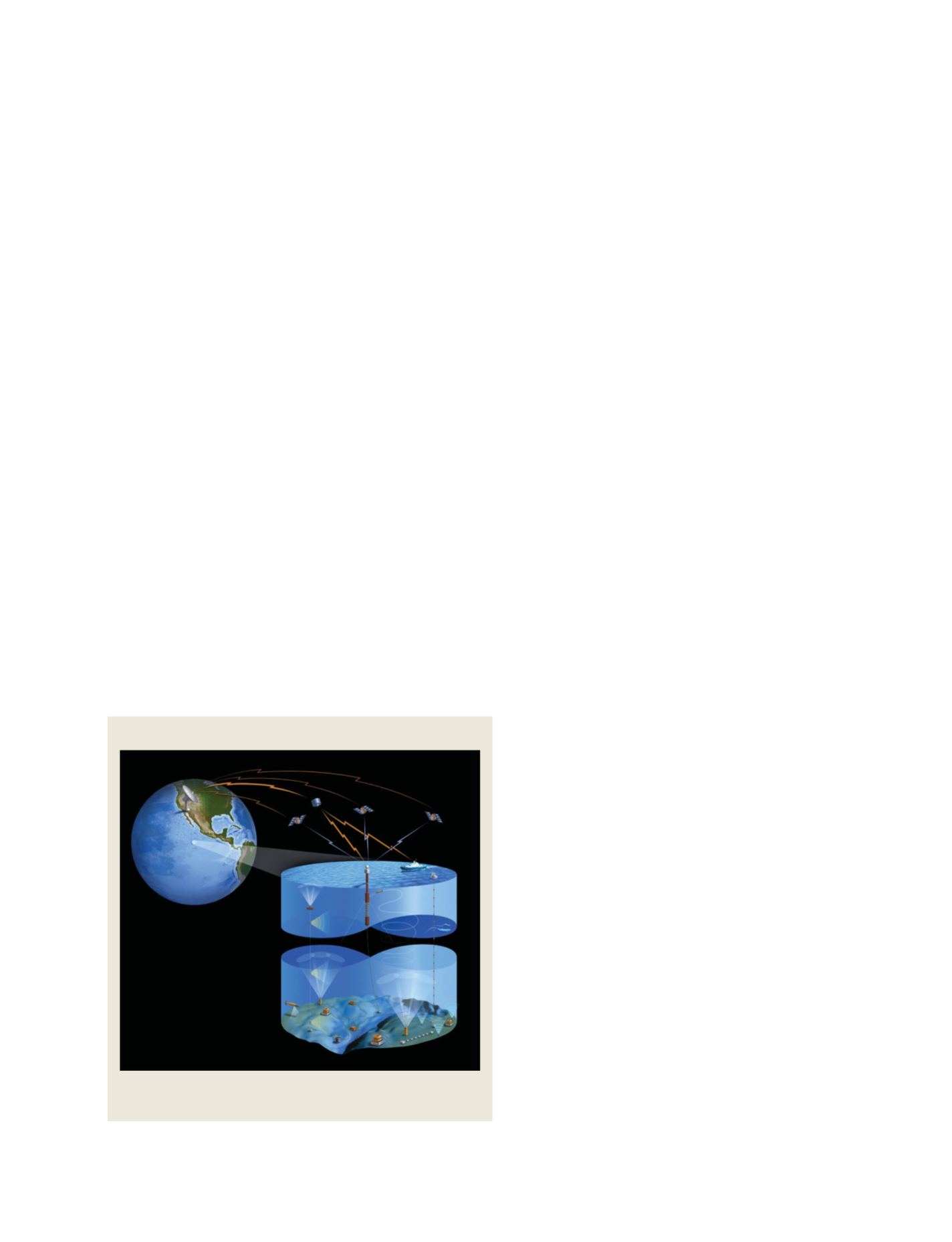

Greenland’s glaciers have become steady downspouts. The melting
of ice sheets and glaciers raises sea level, which will eventually affect
low-lying coastal areas around the globe, and perhaps alter the flow
of major ocean currents.
To improve our knowledge of environmental change in the Arctic
and the understanding of its consequences, NSF is taking the lead
in helping to develop an Arctic Observing Network (AON). In
parallel with AON, NSF is contributing to POLENET, an interna-
tional observing effort for, as its title suggests, both the Arctic and
Antarctic. In Greenland, for example, the deployment of a network
of POLENET global positioning system sensors will allow scien-
tists to ‘weigh’ the continent’s ice sheet and detect changes in its
mass, changes that may well affect global sea level.
AON and POLENET are major US contributions to the
International Polar Year (IPY 2007-2009), the largest scientific
study to date of the Arctic and Antarctic. The project involves thou-
sands of scientists from more than 60 countries. It is the fourth
such polar year, following those in 1882-3, 1932-3, and 1957-8
(the International Geophysical Year). In the context of the sensi-
tivity of Earth’s poles to accelerating climate change, it’s also
perhaps the most important IPY so far.
Connecting it all: environmental observatories, data and people
The development of cyberinfrastructure (digital information and
communication capabilities), and continued research in computer
and information science, are integral to environmental observing
capabilities. The explosion of real-time data calls for near real-time
analysis and distribution if those data are to be most useful, espe-
cially in saving lives during hurricanes or earthquakes, or
predicting likely outbreaks of infectious diseases. How we manage
a constant flow of data is essential to the effectiveness of environ-
mental observatories.
“To maximize the benefit of these investments, the
development of extended observing systems must be
coordinated with research on environmental cyberinfra-
structure,” states the 2005 NSF report,
Complex
Environmental Systems: Pathways to the Future.
“Environmental cyberinfrastructure supports not only
integrated access to data flowing from these observing
systems, but also the wealth of environmental data held
in existing databases.”
The relevance of this information to the daily lives of
citizens underscores the importance of basic research.
Earth observatories offer unique opportunities to
improve education at all levels. They also engage the
public in an effort that is global and at the same time,
personal.
“Coupled with continuing improvements in micro-
processor speeds, converging advances in networking,
software, visualization, data systems, and collabora-
tion platforms are changing the way research and
education are accomplished,” states the 2007 NSF
report,
Cyberinfrastructure Vision for 21st Century
Discovery.
“Cyberinfrastructure-enhanced discovery
and learning is especially exciting because of the
opportunities it affords for broadened participation
and wider diversity among individual, geographical,
and institutional dimensions.” The NSF-supported
education projects with national and international
reach have now begun to take advantage of all these
possibilities.
FromManhattan to Bangladesh, sea-level rise will even-
tually affect everyone who lives along the world’s coasts.
Whether on a rice farm in Asia or a wheat farm in
America, climate change is already affecting the fields and
agriculture. In malaria-prone African countries, or out of
Africa where climate is warming and malaria-carrying
mosquitoes may now take up residence, new infectious
diseases are on the way.
We are at a critical point in understanding the relation-
ship between human systems and the rest of Earth’s
systems. The global population is now more than six
billion people. In the next hundred years, that number
may reach ten billion.
In the 21st century, we will make the choices that affect
the most basic relationships between humans and the
planet on which we live. How will we accommodate our
needs, while maintaining the functions of the natural
systems on which the future of the globe, and with it our
existence, depend?
The challenge will be met, in large part, through basic
research: By developing an understanding of the inter-
play of Earth’s complex systems and how people function
in and perceive the world they inhabit. This information
will be used to predict what will happen in the years and
decades ahead. In order to adapt to a changing world, and
to mitigate changes that are already occurring, such
knowledge is critical.
Solutions will come through the use of many eyes in the
sky and ears on the ground: the network of networks of
research environmental observing systems.
1
[
] 91
The Ocean Observatories Initiative
NSF’s OOI will gather continuous observations from near-shore and
remote areas of the seas
Source: Scripps Institution of Oceanography/Ocean Observatories Initiative
GEOSS C
OMPONENTS
– O
BSERVING
S
YSTEMS
















